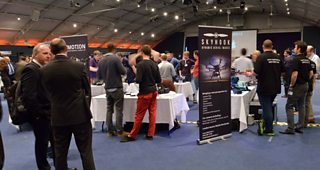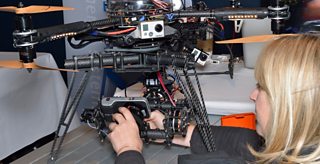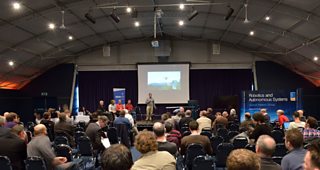I’m Ant Miller, Senior Research Manager in �������� R&D and on Thursday of last week we co-hosted, alongside the , the first ever UAS in Broadcasting conference in the UK, at in Northamptonshire. Over 200 attendees joined the conference, including 20 exhibitors, and over multi stranded presentations (and copious coffee breaks) they explored the technology, craft, regulation and future of the use of Unmanned Aircraft Systems in making television.
The timing of the event was particularly pertinent, as only last week �������� News ran its first news story produced using the corporation’s own in house UAS capabilities, an event noted by the reporter Richard Westcott in a . Alongside the development of internal capabilities, the �������� has for several years now been calling upon the wider community of independent operators of UAS to provide filming services for shows as diverse as Great British Bake Off and Top Gear.

UAS in Broadcast featured operators, manufacturers and distributors
Why Hold the Event?
Here in R&D our focus has been on seeking out the best in operations and technology, trialling and experimenting with them, and ensuring the widest possible distribution of the knowledge and understanding of this challenging new tech amongst our program making colleagues. This has included an with the to develop a long endurance camera platform (as featured on Blue Peter!) and a range of comms activity to educate and train and give guidance to our colleagues. As the industry and the range of capabilities has grown rapidly in the last few years it’s become clear to us that we needed to expand the reach of the communications, and bring together not only our own program makers and engineers, but the wider industry too. So following the we decided to hold a forum, with the support of the SIG of the ESP KTN, to bring together the industry.
The aims of the event were three fold:
1. Raise the Game: we wanted to increase the understanding of UAS amongst broadcasters and of broadcast amongst the UAS operators across the board, for the benefit of all.
2. Bring a Community Together and Create a Coherent Voice: with over 250 operators with CAA permits in the UK it’s a large community, but it needed a space to come together and hopefully form a coherent voice to address the industries point of view to regulators, legislators and the wider press.
3. Explore Avenues for UK R&D Investment: the RAS SIG in particular wanted to identify opportunities and direct R&D funding toward projects and initiatives that have the potential to make a real impact in the UK UAS marketplace, and the wider global sphere.
The Event Itself
Sywell provided a great space for the event. We had 200 attendees, and used Hangar 1 for the main exhibition space and for the auditorium for the plenary and one stream of presentations, and the smaller Hanger 2 for the second stream, which included panel discussions.
Our exhibitors included operators, distributors and manufacturers, and not just those of UAS. These days there are camera and accessory manufacturers interested in this specific market, and we saw representation from those areas too. What was particularly notable of the operators exhibiting was that although on first glance all had remarkably similar core technologies in terms of their flying platforms, each has developed a specific specialisation around the payloads, skills and operations that they can achieve. It’s a remarkably complex industry, with specialisation and niche expertise rather than outright competition being the order of the day.

An example of a UAS mounted Blackmagic Pocket Cinema camera at the Helicoptergirls stand
Our opening keynotes covered Legal and Regulatory matters, and two areas of technology research. Gerry Corbett and Mike Gadd of the CAA gave an excellent overview of the rational and practicalities of the current UK airspace and airworthiness regulations as they apply in the UK. At heart it’s a pretty simple and straightforward scheme, with lots of flexibility to incorporate the capabilities of responsible safe operators alongside other air uses and the public in a safe way. Mike and Gerry also joined the later panel on Regulation. It’s very reassuring to see a regulator so willing to engage with the industry in such an open way.
The keynotes from Pietro Amati ofand Nick Tudor of explored different aspects of the technologies underpinning UAS- both gave fascinating pointers to the potential for developments to open new operational opportunities.
Peter Tailor ofclosed the keynotes with his strategic overview of the legal landscape within which UAS must operate. Alongside the well-recognised aviation regulation field Peter outlined many other aspects of legal consideration that operators need to address, and even managed to slip in a reference to the Karma Sutra in his deck.

Nick Pinks of �������� R&D introduced some of the presentations
Sessions through the rest of the day had four main themes:
• Broadcast best practice drilled into the operational experiences of a range of operators, and �������� program makers, to draw out the key factors for a successful production.
• Advanced R&D looked at the latest work from universities and commercial researchers, including the in the North West of England, Southampton University and the fascinating new technology
• Latest Tech for Broadcast gave an overview of some of the latest tools and technologies to appear on the market in the last few months, and also included a potted overview of the best �������� guidance on selecting the best camera to use for a production.
• Regulation Evolution was a panel session led by Jessica Bland of Nesta exploring the current state of regulation and training, and exploring how the current system could be improved or used better to give a safer industry with greater capabilities.
Thanks to the excellent staff in Sywell Tower we were able to use a small corner of the aerodrome for live flying displays during our lunch break. Under CAP658 flying display rules several manufacturers were able to demonstrate the capabilities of their systems.
We were lucky enough to have Guy Pelham of �������� News provide our closing keynote. Guy’s experience as a senior editor in news, and running the ��������’s aviation assets for several years gives him a unique strategic overview of this industry, and one which he has presented internationally. We’re very grateful for his closing presentation, which gave a great summary to what was a fascinating, exciting, and really rather enjoyable day.
�������� R&D is now winding down the current UAS activity and this conference marked a key stage in the transition from a research driven effort into ‘business as usual’. The safety, procurement, news, and television production areas all now have their key experts in this technology in place, and unless a specific new capability is required by the �������� that needs a dedicated R&D effort, there are no further R&D activities in this area planned.
The conference was only possible thanks to the efforts of a team drawn from across R&D, the wider �������� and the RAS SIG: Tony Richardson, Duncan Inch, Alia Sheikh, Kevin Claydon, Nick Pinks, Nick Roxburgh, Guy Pelham, Jonathan Renouf, Michael Drake, David Turnbull, Theo Webb, Robert Wilcox, Dan Rees, and Phil Williams, Francesca Trotta, Louisa Chanter and colleagues.
Ant Miller is a Senior Research Manager in �������� R&D
